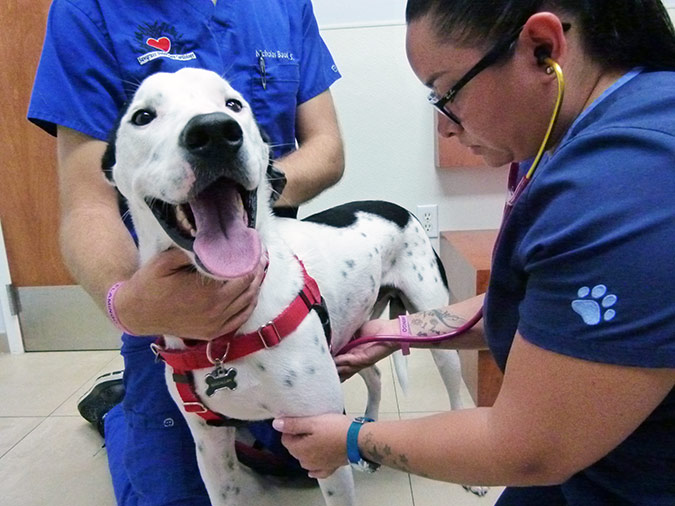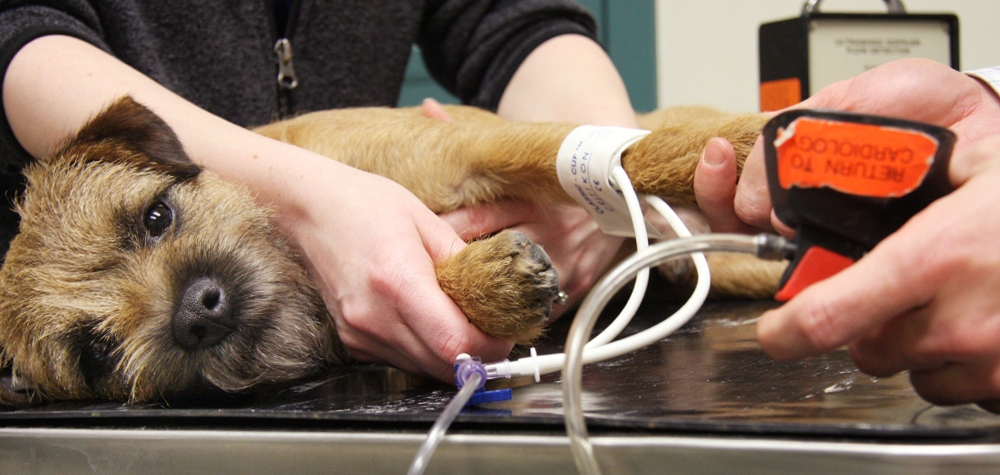What You Required to Find Out About Vet Services: An Overview of Diagnostic Devices and Procedures
Veterinary solutions play an important role in maintaining the health and wellness of family pets. Normal check-ups can disclose covert health problems early. Different analysis devices and procedures, such as blood examinations and imaging strategies, offer necessary insights right into a pet's well-being. Comprehending these methods is essential for family pet proprietors. What specific analysis treatments are most typically made use of, and exactly how can they influence an animal's therapy plan?
Significance of Regular Vet Examinations
While many pet proprietors may take too lightly the importance of routine vet check-ups, these visits are important for keeping an animal's total health. Regular check outs to the veterinarian enable early detection of prospective wellness concerns prior to they intensify right into serious problems. Regular exams commonly consist of inoculations, which are essential for protecting against transmittable illness that might badly affect a pet dog's health. Additionally, these appointments provide an opportunity for veterinarians to assess the pet's weight, oral wellness, and total problem, ensuring that the animal is flourishing. During these brows through, pet dog owners can additionally obtain beneficial recommendations on diet regimen, exercise, and preventive care tailored to their details family pet's demands.
Typical Diagnostic Treatments in Veterinary Medicine
In vet medicine, precise medical diagnosis is crucial for efficient treatment. Usual analysis procedures consist of blood screening methods, advanced imaging modern technologies, and urinalysis, each playing a substantial duty in identifying health and wellness problems. Recognizing these approaches enhances the capability to supply ideal take care of pet clients.
Blood Checking Strategies
Blood screening methods work as necessary diagnostic devices in vet medication, allowing vets to evaluate the health of pets accurately. These strategies include gathering blood samples to analyze different components, such as red and white blood cells, platelets, and biochemical pens. Typical examinations include total blood counts (CBC), which examine overall wellness and discover infections, and biochemical panels, which analyze organ function and metabolic standing. Additionally, serological examinations can recognize specific illness through antibody discovery. Blood screening is minimally intrusive and gives vital details that assists in diagnosing problems, monitoring health and wellness status, and assessing reactions to treatments. Overall, these techniques play an important function in guaranteeing suitable take care of pet dogs and livestock alike.
Imaging Technologies Used
Diagnostic imaging innovations are essential tools in veterinary medicine, enhancing blood screening methods by giving visual insights right into a pet's internal structures. Usual imaging techniques include X-rays, which work for evaluating bone cracks and detecting foreign objects, and ultrasound, which permits for real-time visualization of soft cells and body organs. Magnetic vibration imaging (MRI) provides thorough photos of complicated physiological locations, specifically in neurological assessments. Computed tomography (CT) provides cross-sectional pictures, enhancing analysis accuracy for different conditions. Each of these innovations help vets in identifying illnesses, intending treatments, and keeping track of healing. By incorporating imaging innovations, veterinary experts can better assess a pet's health and make informed choices regarding their care.
Urinalysis and Diagnostics
Urinalysis functions as an important diagnostic tool in veterinary medicine, supplying beneficial understandings into a pet's overall health and wellness and aiding in the discovery of numerous conditions. This non-invasive treatment examines pee examples to analyze kidney feature, hydration status, and metabolic conditions. Usual elements analyzed include specific gravity, pH levels, glucose, proteins, and the existence of blood or germs. Irregular findings can indicate concerns such as urinary system tract infections, diabetes mellitus, or kidney disease. To enhance analysis precision, urinalysis is frequently performed along with other examinations, such as blood work and imaging research studies. Early discovery through urinalysis can bring about timely treatments, boosting the diagnosis for several veterinary patients. As a result, it is a vital facet of thorough vet treatment.
Recognizing Blood Tests and Lab Evaluation
Understanding blood tests and lab analysis is important in vet medicine as it aids in detecting various wellness problems in pets. Different kinds of blood examinations give necessary information regarding an animal's interior state, while translating lab results requires mindful consideration of numerous factors. This section will check out the kinds of blood tests readily available and the value of their results.
Sorts Of Blood Tests
Blood tests play a crucial role in veterinary medicine, offering necessary understandings right into an animal's wellness standing. Various kinds of blood tests are utilized, each serving different purposes. Total blood matters (CBC) evaluate general health and wellness and discover problems such as anemia or infection. Biochemical profiles examine organ feature by gauging electrolytes and enzymes, supplying insights into metabolic health and wellness. Serological examinations determine specific antibodies or pathogens, assisting in the diagnosis of infections or autoimmune conditions. Blood inputting guarantees risk-free transfusions, while coagulation examinations gauge the blood's ability to embolisms, important for surgical treatments. These examinations collectively enhance diagnosis, therapy preparation, and surveillance of an animal's wellness, highlighting the value of detailed lab evaluation in vet care.

Analyzing Lab Results
An extensive evaluation of lab results is necessary for accurate diagnosis and therapy in veterinary medication. Interpreting laboratory results needs an understanding of typical referral ranges and the importance of discrepancies. Blood examinations can disclose numerous health and wellness signs, such as organ feature, electrolyte equilibrium, and the visibility of infections. Veterinarians must take into consideration the entire clinical photo, including the pet's history, health examination searchings for, and any kind of signs offered. Variations in results might arise from aspects such as age, breed, and underlying wellness i thought about this conditions. Lab outcomes need to not be seen in isolation but instead as component of a comprehensive diagnostic technique. Exact interpretation enables customized treatment plans and much better results for vet individuals.
Imaging Techniques: X-rays, Ultrasounds, and Beyond
Imaging strategies are important tools in vet my company medicine, providing critical insights right into the health and wellness and health of animals. Amongst the most frequently made use of techniques are Ultrasounds and x-rays. X-rays are indispensable for imagining bone frameworks, assisting veterinarians recognize cracks, growths, or foreign items. This method is non-invasive and fast, making it perfect for urgent situations.Ultrasounds, on the various other hand, utilize sound waves to develop photos of soft tissues and body organs. This technique is particularly helpful for analyzing the heart, abdominal area, and reproductive body organs, enabling vets to evaluate problems like liquid buildup or organ abnormalities.Beyond X-rays and ultrasounds, progressed imaging techniques such as computed tomography (CT) and magnetic vibration imaging (MRI) are progressively made use of in vet technique. These approaches supply comprehensive cross-sectional pictures, boosting the accuracy of diagnoses and treatment strategies. CT Scans For Dogs. In general, imaging techniques play an important duty in guaranteeing reliable vet care
The Role of Biopsies in Diagnosing Animal Health Issues
Precision in detecting health and wellness issues in animals usually depends upon making use of biopsies, which supply clear-cut information concerning cells irregularities. A biopsy entails the elimination of a tiny example of cells for assessment under a microscope, allowing veterinarians to identify various conditions, including infections, lumps, and inflammatory illness. This diagnostic tool is important for distinguishing between deadly and benign growths, leading therapy decisions, and reviewing the seriousness of a condition.Biopsies can be carried out making use of numerous strategies, such as needle desire, incisional biopsies, or excisional biopsies, depending on the area and kind of cells involved. The selection of method may affect recovery time and the amount of tissue gathered. Ultimately, the details obtained from a biopsy can cause targeted therapies, improving results for pet dogs dealing with significant health difficulties. Vets highlight the importance of this treatment in achieving exact medical diagnoses and efficient therapy plans.
Advanced Diagnostic Devices: Endoscopy and CT Scans

Advanced diagnostic tools, such as endoscopy and CT scans, play a crucial duty in contemporary vet medicine, supplying non-invasive methods to picture internal structures and detect various problems in family pets. Endoscopy involves the use of a flexible tube geared up with an electronic camera, allowing veterinarians to examine the intestinal system and breathing system straight. This method can expose irregularities such as tumors, foreign bodies, or inflammation, making it possible for targeted treatment plans.CT scans, on the various other hand, make use of sophisticated imaging technology to produce comprehensive cross-sectional photos of the body (Cancer Veterinary Near Me). This technique is particularly helpful go to website for evaluating complex frameworks like the mind, spine, and joints. By providing high-resolution photos, CT scans aid vets in identifying concerns that might not appear through conventional radiography. Together, these innovative tools enhance analysis precision, enhance treatment outcomes, and eventually add to better overall animal wellness administration

Translating Test Results: What Pet Dog Owners Should Know
Recognizing test outcomes can be a tough task for pet proprietors, specifically after sophisticated procedures like endoscopy and CT scans have actually been done. Interpreting these outcomes requires a grasp of clinical terms and a clear understanding of what the searchings for indicate concerning the pet dog's health. Veterinarians commonly give descriptions, but the intricacy of the outcomes can still result in confusion.Pet owners should proactively involve in conversations with their veterinarians, asking inquiries to clear up any kind of uncertainties. It is necessary to understand abnormal versus normal results and the ramifications for the pet's therapy strategy. In addition, identifying that some outcomes may require further screening or monitoring can aid owners remain notified regarding their pet dog's wellness journey. Ultimately, a joint method between pet dog proprietors and veterinary professionals fosters better health and wellness results and enhances the general treatment experience for pets.
Frequently Asked Concerns
Exactly how Do I Select the Right Veterinary Facility for My Family pet?
Selecting the appropriate veterinary clinic involves looking into neighborhood alternatives, reviewing qualifications, going to centers, and assessing team communications (Cancer Veterinary Near Me). Prioritizing referrals from trusted sources can assist guarantee the most effective care and atmosphere for an animal's health and wellness needs
What Should I Do if My Family Pet Rejects to visit the Vet?
When a pet dog rejects to visit the vet, it's recommended to remain tranquil, use treats or toys to entice them, and think about arranging a home visit if anxiety lingers. Perseverance and positive support are crucial.
Exist Telehealth Options for Vet Providers?
Telehealth choices for veterinary solutions are progressively offered, allowing animal proprietors to consult with veterinarians from another location. These solutions make it possible for discussions regarding wellness worries, guidance on minor conditions, and follow-ups without requiring to go to a center.
Exactly how Frequently Should My Pet Dog Have Oral Exams?
The regularity of dental exams for pet dogs normally relies on their age and breed. Generally, veterinarians recommend annual oral analyses, although some pets might require even more frequent brows through to keep perfect dental health.

What Are the Costs Connected With Vet Diagnostics?
The prices associated with veterinary diagnostics can vary commonly, generally varying from standard examinations like blood job to advanced imaging strategies. Aspects influencing expenditures include the facility's location, equipment utilized, and particular examinations needed for every pet dog. Vet services play a crucial function in keeping the health and wellness of pet dogs. While lots of pet proprietors may underestimate the relevance of normal vet exams, these consultations are important for preserving an animal's general health and wellness. Furthermore, these consultations give an opportunity for vets to examine the animal's weight, dental health, and total condition, guaranteeing that the family pet is thriving. Accuracy in diagnosing wellness issues in pets usually pivots on the use of biopsies, which offer definitive info about cells irregularities. Additionally, acknowledging that some outcomes may call for additional testing or tracking can aid owners stay informed regarding their animal's health trip.
Comments on “A Pet Owner’s Guide to the Cost and Purpose of CT Scans For Animals}”